light BMW 535I XDRIVE GT 2011 F07 Owner's Guide
[x] Cancel search | Manufacturer: BMW, Model Year: 2011, Model line: 535I XDRIVE GT, Model: BMW 535I XDRIVE GT 2011 F07Pages: 297, PDF Size: 8.59 MB
Page 59 of 297
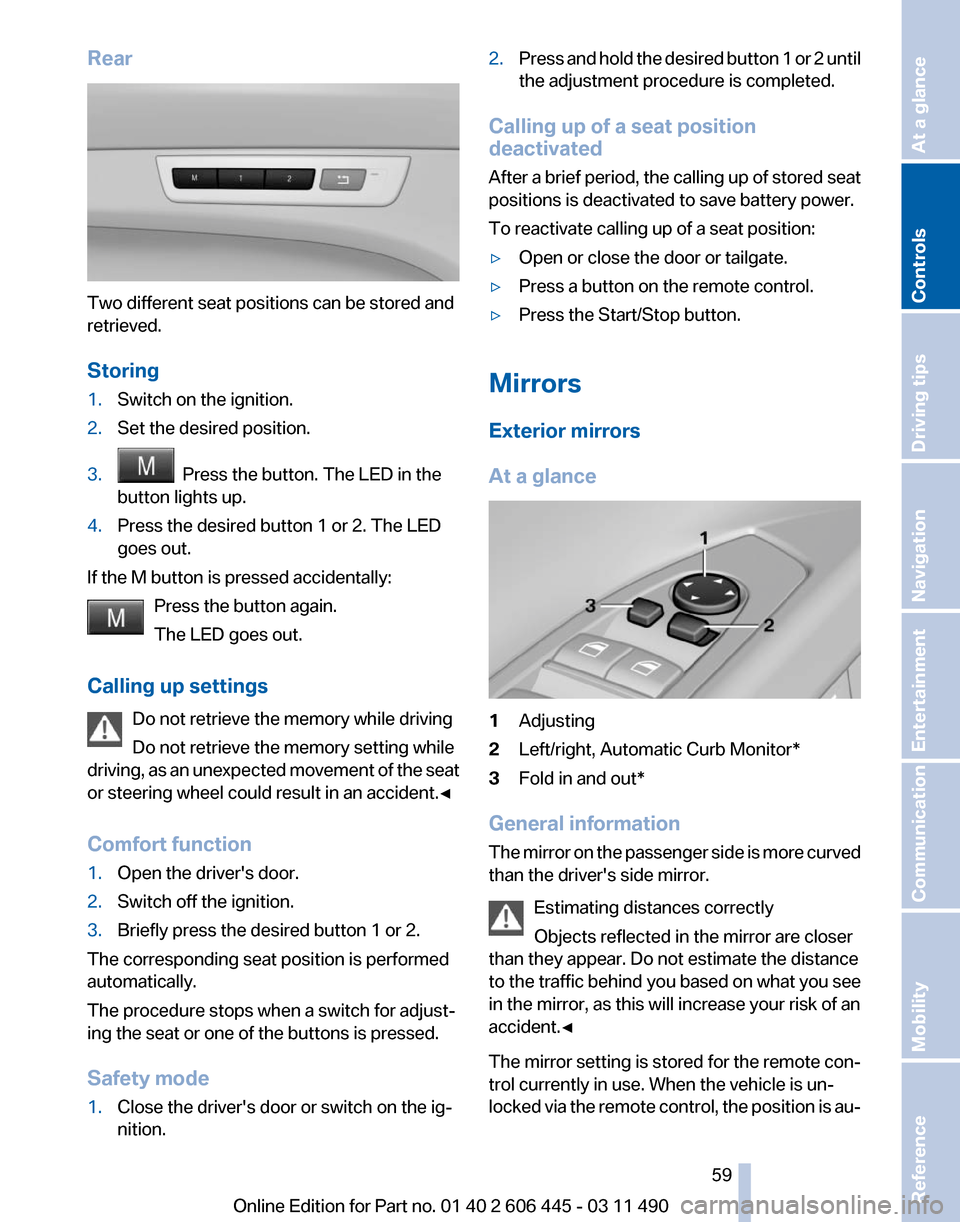
Rear
Two different seat positions can be stored and
retrieved.
Storing
1.
Switch on the ignition.
2. Set the desired position.
3. Press the button. The LED in the
button lights up.
4. Press the desired button 1 or 2. The LED
goes out.
If the M button is pressed accidentally: Press the button again.
The LED goes out.
Calling up settings Do not retrieve the memory while driving
Do not retrieve the memory setting while
driving,
as an unexpected movement of the seat
or steering wheel could result in an accident.‚óÄ
Comfort function
1. Open the driver's door.
2. Switch off the ignition.
3. Briefly press the desired button 1 or 2.
The corresponding seat position is performed
automatically.
The procedure stops when a switch for adjust‚Äź
ing the seat or one of the buttons is pressed.
Safety mode
1. Close the driver's door or switch on the ig‚Äź
nition. 2.
Press and hold the desired button 1 or 2 until
the adjustment procedure is completed.
Calling up of a seat position
deactivated
After
a brief period, the calling up of stored seat
positions is deactivated to save battery power.
To reactivate calling up of a seat position:
‚Ė∑ Open or close the door or tailgate.
‚Ė∑ Press a button on the remote control.
‚Ė∑ Press the Start/Stop button.
Mirrors
Exterior mirrors
At a glance 1
Adjusting
2 Left/right, Automatic Curb Monitor*
3 Fold in and out*
General information
The
mirror on the passenger side is more curved
than the driver's side mirror.
Estimating distances correctly
Objects reflected in the mirror are closer
than they appear. Do not estimate the distance
to the traffic behind you based on what you see
in the mirror, as this will increase your risk of an
accident.‚óÄ
The mirror setting is stored for the remote con‚Äź
trol currently in use. When the vehicle is un‚Äź
locked via the remote control, the position is au‚Äź Seite 59
59Online Edition for Part no. 01 40 2 606 445 - 03 11 490
Reference Mobility Communication Entertainment Navigation Driving tips
Controls At a glance
Page 60 of 297
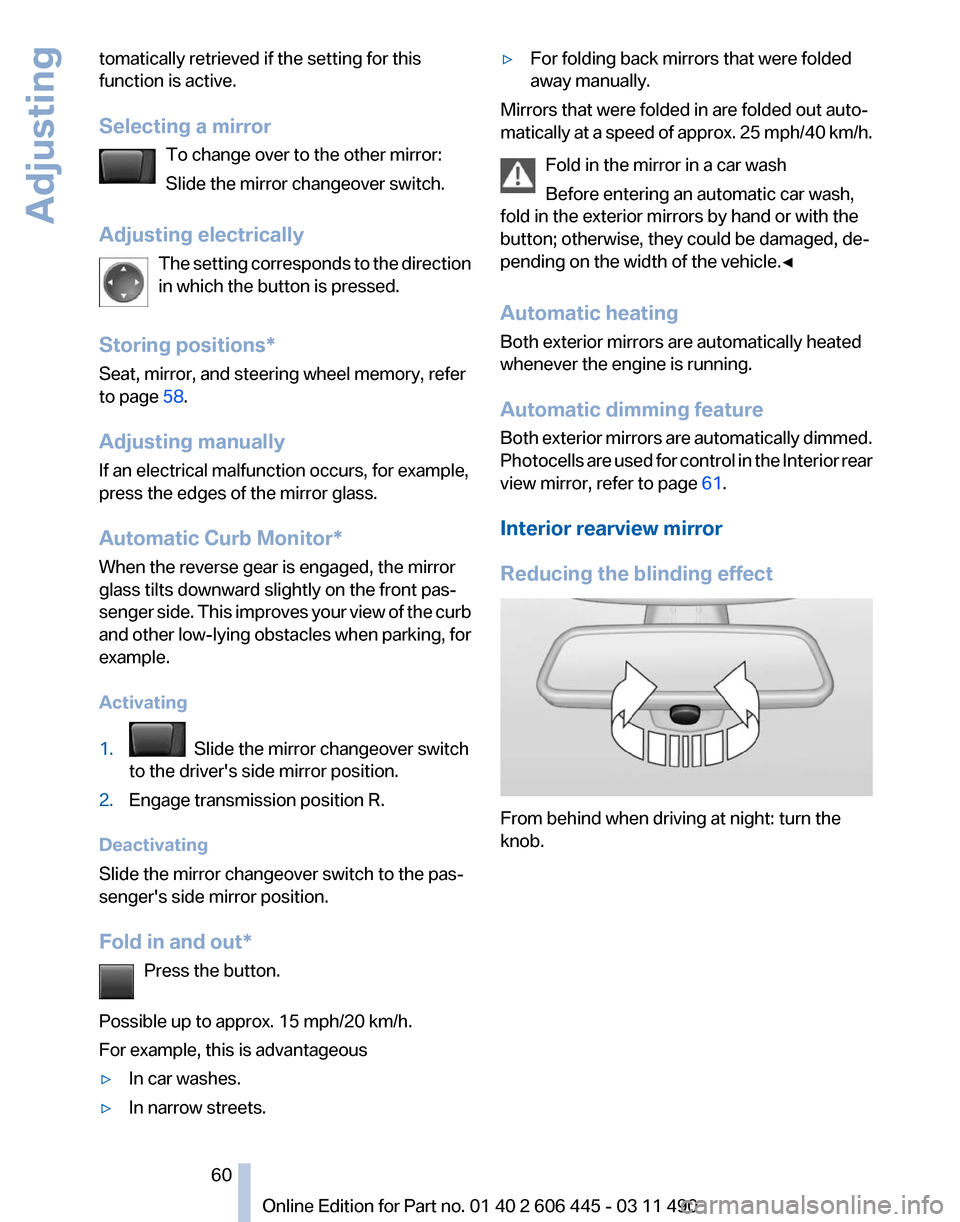
tomatically retrieved if the setting for this
function is active.
Selecting a mirror
To change over to the other mirror:
Slide the mirror changeover switch.
Adjusting electrically The
setting corresponds to the direction
in which the button is pressed.
Storing positions*
Seat, mirror, and steering wheel memory, refer
to page 58.
Adjusting manually
If an electrical malfunction occurs, for example,
press the edges of the mirror glass.
Automatic Curb Monitor*
When the reverse gear is engaged, the mirror
glass tilts downward slightly on the front pas‚Äź
senger side. This improves your view of the curb
and other low-lying obstacles when parking, for
example.
Activating
1. Slide the mirror changeover switch
to the driver's side mirror position.
2. Engage transmission position R.
Deactivating
Slide the mirror changeover switch to the pas‚Äź
senger's side mirror position.
Fold in and out* Press the button.
Possible up to approx. 15 mph/20 km/h.
For example, this is advantageous
‚Ė∑ In car washes.
‚Ė∑ In narrow streets. ‚Ė∑
For folding back mirrors that were folded
away manually.
Mirrors that were folded in are folded out auto‚Äź
matically
at a speed of approx. 25 mph/40 km/h.
Fold in the mirror in a car wash
Before entering an automatic car wash,
fold in the exterior mirrors by hand or with the
button; otherwise, they could be damaged, de‚Äź
pending on the width of the vehicle.‚óÄ
Automatic heating
Both exterior mirrors are automatically heated
whenever the engine is running.
Automatic dimming feature
Both exterior mirrors are automatically dimmed.
Photocells are used for control in the Interior rear
view mirror, refer to page 61.
Interior rearview mirror
Reducing the blinding effect From behind when driving at night: turn the
knob. Seite 60
60 Online Edition for Part no. 01 40 2 606 445 - 03 11 490
Adjusting
Page 61 of 297
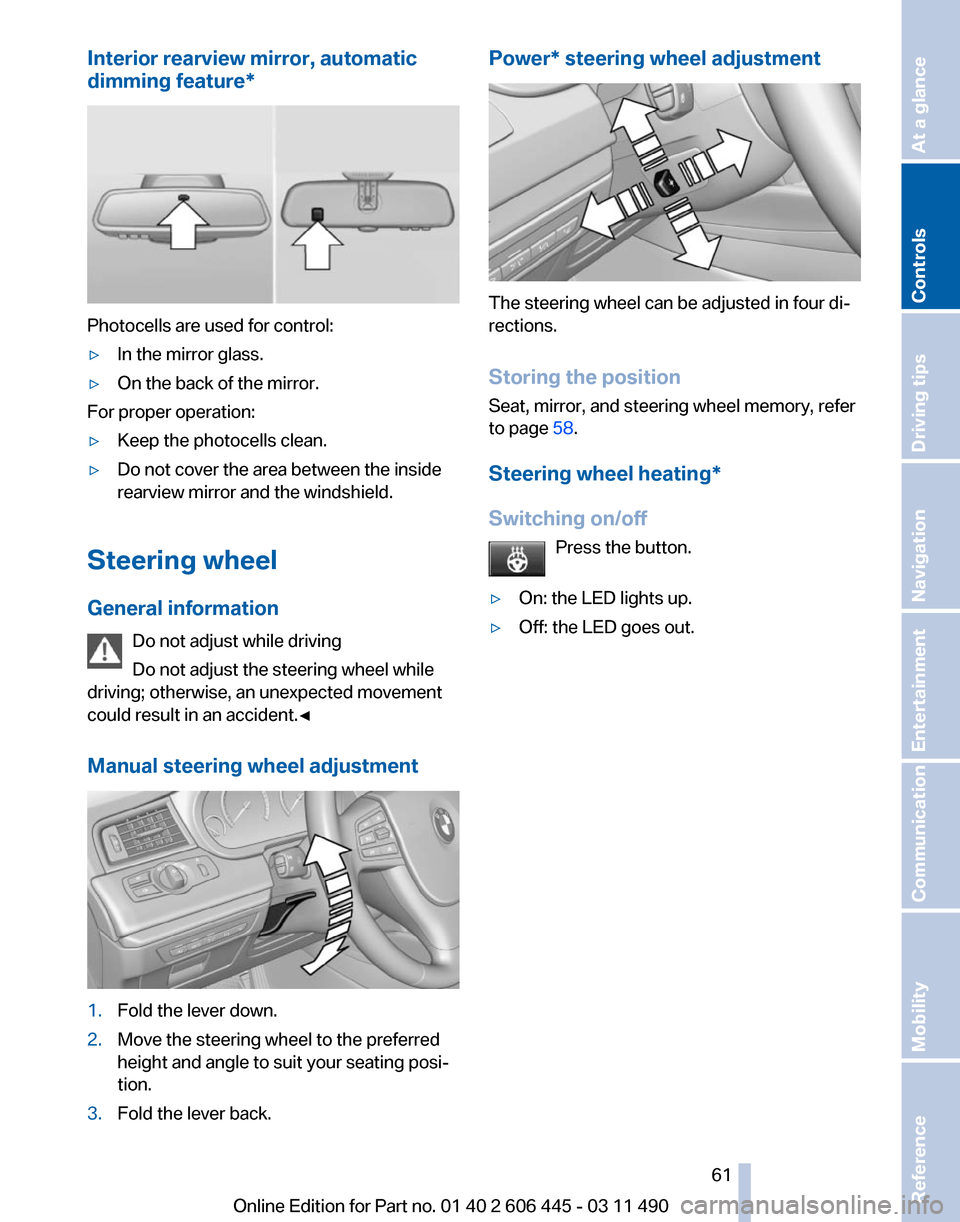
Interior rearview mirror, automatic
dimming feature
*Photocells are used for control:
‚Ė∑
In the mirror glass.
‚Ė∑ On the back of the mirror.
For proper operation:
‚Ė∑ Keep the photocells clean.
‚Ė∑ Do not cover the area between the inside
rearview mirror and the windshield.
Steering wheel
General information Do not adjust while driving
Do not adjust the steering wheel while
driving; otherwise, an unexpected movement
could result in an accident.‚óÄ
Manual steering wheel adjustment 1.
Fold the lever down.
2. Move the steering wheel to the preferred
height and angle to suit your seating posi‚Äź
tion.
3. Fold the lever back. Power* steering wheel adjustment
The steering wheel can be adjusted in four di‚Äź
rections.
Storing the position
Seat, mirror, and steering wheel memory, refer
to page
58.
Steering wheel heating
*
Switching on/off Press the button.
‚Ė∑ On: the LED lights up.
‚Ė∑ Off: the LED goes out. Seite 61
61Online Edition for Part no. 01 40 2 606 445 - 03 11 490
Reference Mobility Communication Entertainment Navigation Driving tips
Controls At a glance
Page 64 of 297
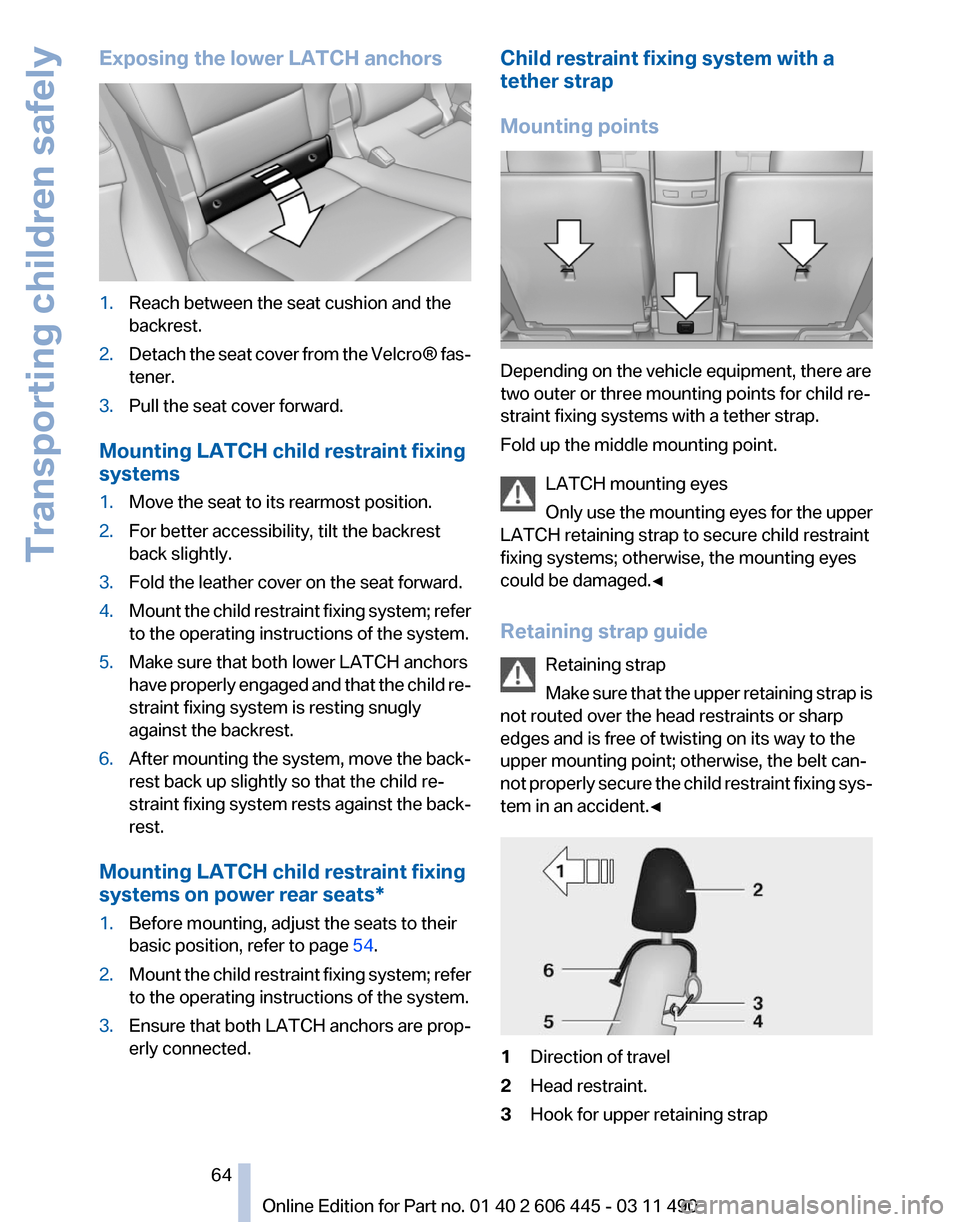
Exposing the lower LATCH anchors
1.
Reach between the seat cushion and the
backrest.
2. Detach the seat cover from the Velcro¬ģ fas‚Äź
tener.
3. Pull the seat cover forward.
Mounting LATCH child restraint fixing
systems
1. Move the seat to its rearmost position.
2. For better accessibility, tilt the backrest
back slightly.
3. Fold the leather cover on the seat forward.
4. Mount the child restraint fixing system; refer
to the operating instructions of the system.
5. Make sure that both lower LATCH anchors
have
properly engaged and that the child re‚Äź
straint fixing system is resting snugly
against the backrest.
6. After mounting the system, move the back‚Äź
rest back up slightly so that the child re‚Äź
straint
fixing system rests against the back‚Äź
rest.
Mounting LATCH child restraint fixing
systems on power rear seats
*
1. Before mounting, adjust the seats to their
basic position, refer to page 54.
2. Mount the child restraint fixing system; refer
to the operating instructions of the system.
3. Ensure that both LATCH anchors are prop‚Äź
erly connected. Child restraint fixing system with a
tether strap
Mounting points
Depending on the vehicle equipment, there are
two outer or three mounting points for child re‚Äź
straint fixing systems with a tether strap.
Fold up the middle mounting point.
LATCH mounting eyes
Only
use the mounting eyes for the upper
LATCH retaining strap to secure child restraint
fixing systems; otherwise, the mounting eyes
could be damaged.‚óÄ
Retaining strap guide
Retaining strap
Make sure that the upper retaining strap is
not routed over the head restraints or sharp
edges and is free of twisting on its way to the
upper mounting point; otherwise, the belt can‚Äź
not properly secure the child restraint fixing sys‚Äź
tem in an accident.‚óÄ 1
Direction of travel
2 Head restraint.
3 Hook for upper retaining strap Seite 64
64 Online Edition for Part no. 01 40 2 606 445 - 03 11 490
Transporting children safely
Page 66 of 297
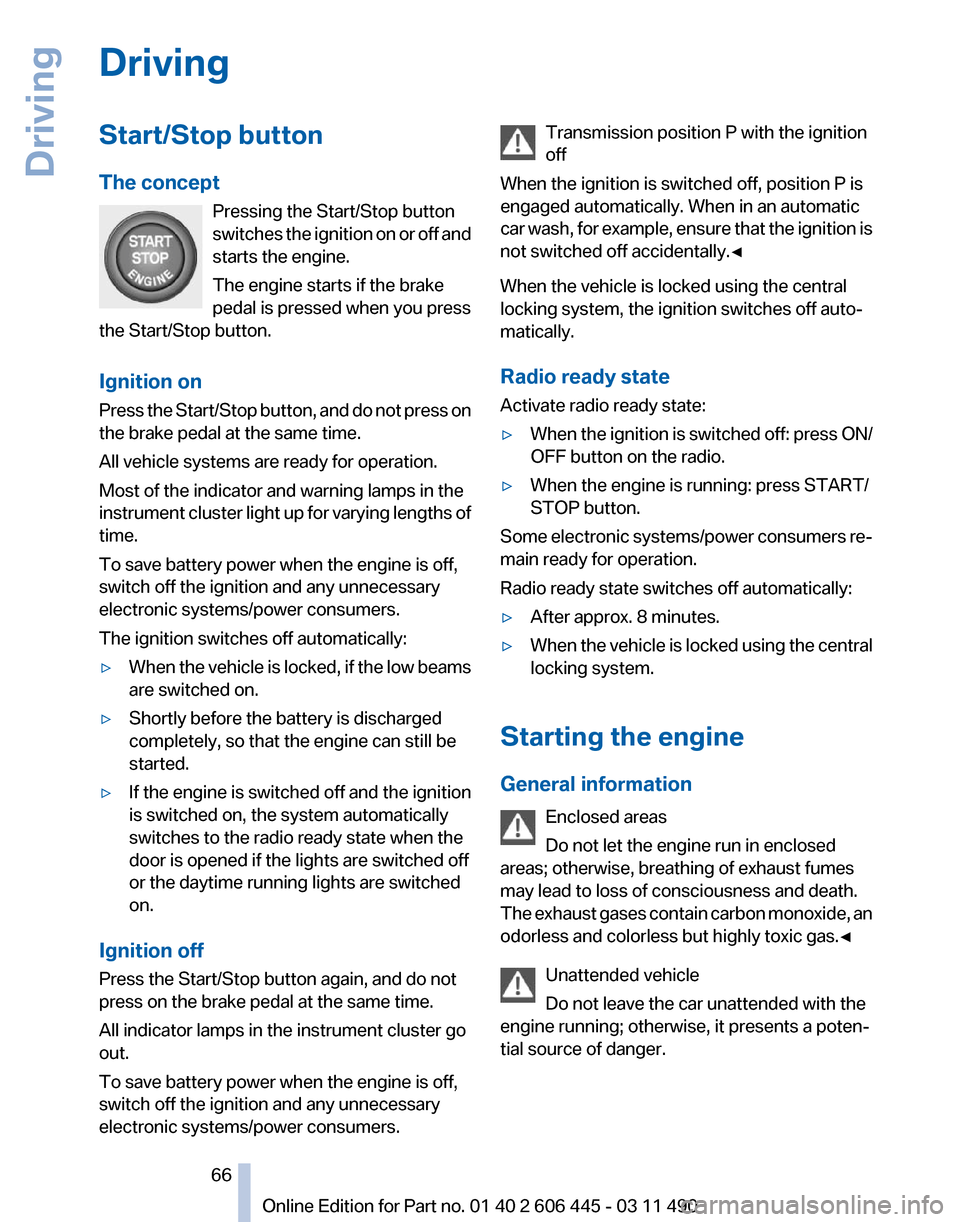
Driving
Start/Stop button
The concept
Pressing the Start/Stop button
switches
the ignition on or off and
starts the engine.
The engine starts if the brake
pedal is pressed when you press
the Start/Stop button.
Ignition on
Press the Start/Stop button, and do not press on
the brake pedal at the same time.
All vehicle systems are ready for operation.
Most of the indicator and warning lamps in the
instrument cluster light up for varying lengths of
time.
To save battery power when the engine is off,
switch off the ignition and any unnecessary
electronic systems/power consumers.
The ignition switches off automatically:
‚Ė∑ When the vehicle is locked, if the low beams
are switched on.
‚Ė∑ Shortly before the battery is discharged
completely, so that the engine can still be
started.
‚Ė∑ If the engine is switched off and the ignition
is switched on, the system automatically
switches to the radio ready state when the
door is opened if the lights are switched off
or the daytime running lights are switched
on.
Ignition off
Press the Start/Stop button again, and do not
press on the brake pedal at the same time.
All indicator lamps in the instrument cluster go
out.
To save battery power when the engine is off,
switch off the ignition and any unnecessary
electronic systems/power consumers. Transmission position P with the ignition
off
When the ignition is switched off, position P is
engaged automatically. When in an automatic
car
wash, for example, ensure that the ignition is
not switched off accidentally.‚óÄ
When the vehicle is locked using the central
locking system, the ignition switches off auto‚Äź
matically.
Radio ready state
Activate radio ready state:
‚Ė∑ When the ignition is switched off: press ON/
OFF button on the radio.
‚Ė∑ When the engine is running: press START/
STOP button.
Some electronic systems/power consumers re‚Äź
main ready for operation.
Radio ready state switches off automatically:
‚Ė∑ After approx. 8 minutes.
‚Ė∑ When the vehicle is locked using the central
locking system.
Starting the engine
General information Enclosed areas
Do not let the engine run in enclosed
areas; otherwise, breathing of exhaust fumes
may lead to loss of consciousness and death.
The
exhaust gases contain carbon monoxide, an
odorless and colorless but highly toxic gas.‚óÄ
Unattended vehicle
Do not leave the car unattended with the
engine running; otherwise, it presents a poten‚Äź
tial source of danger. Seite 66
66 Online Edition for Part no. 01 40 2 606 445 - 03 11 490
Driving
Page 67 of 297
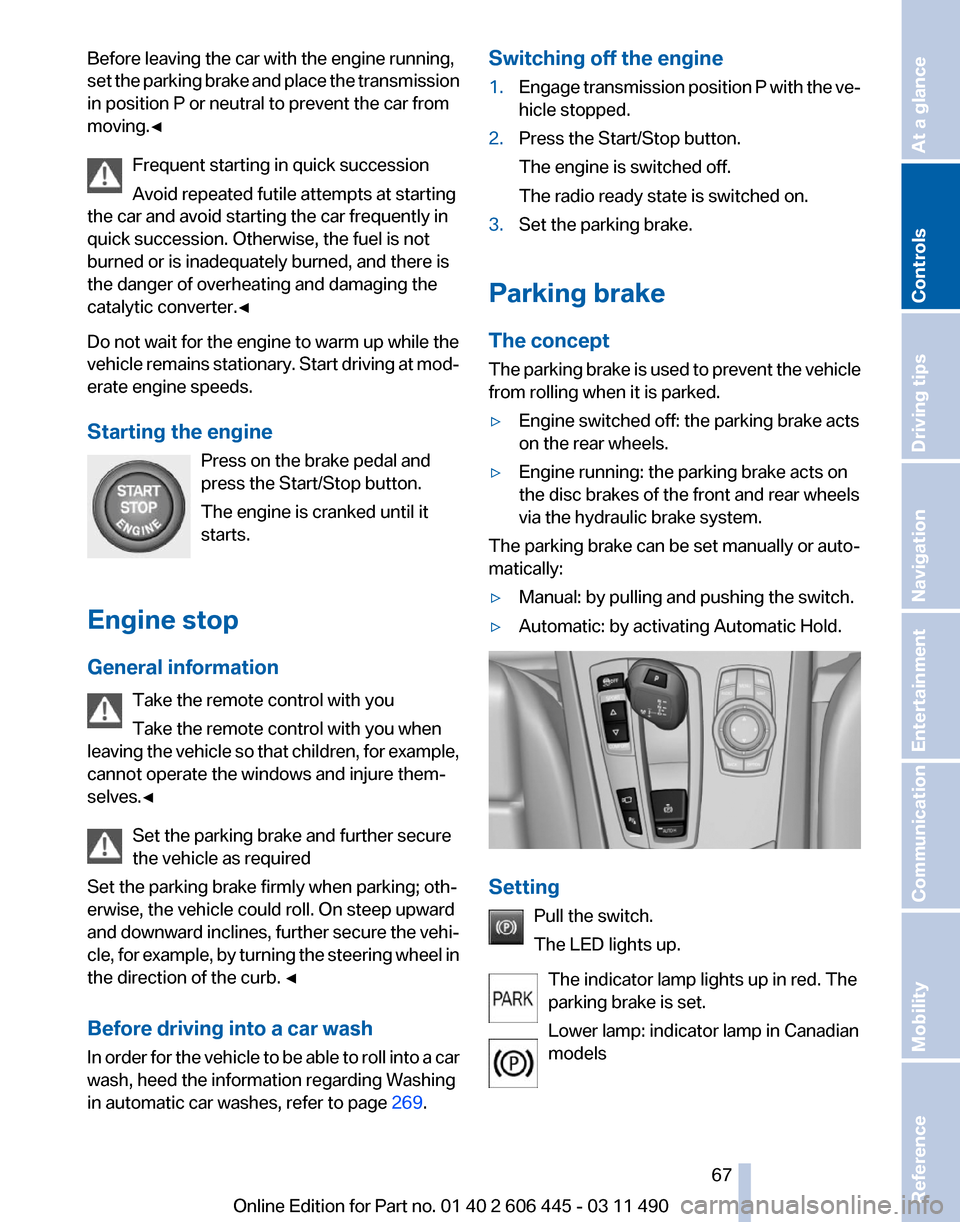
Before leaving the car with the engine running,
set
the parking brake and place the transmission
in position P or neutral to prevent the car from
moving.‚óÄ
Frequent starting in quick succession
Avoid repeated futile attempts at starting
the car and avoid starting the car frequently in
quick succession. Otherwise, the fuel is not
burned or is inadequately burned, and there is
the danger of overheating and damaging the
catalytic converter.‚óÄ
Do not wait for the engine to warm up while the
vehicle remains stationary. Start driving at mod‚Äź
erate engine speeds.
Starting the engine
Press on the brake pedal and
press the Start/Stop button.
The engine is cranked until it
starts.
Engine stop
General information Take the remote control with you
Take the remote control with you when
leaving the vehicle so that children, for example,
cannot operate the windows and injure them‚Äź
selves.‚óÄ
Set the parking brake and further secure
the vehicle as required
Set the parking brake firmly when parking; oth‚Äź
erwise, the vehicle could roll. On steep upward
and downward inclines, further secure the vehi‚Äź
cle, for example, by turning the steering wheel in
the direction of the curb. ‚óÄ
Before driving into a car wash
In order for the vehicle to be able to roll into a car
wash, heed the information regarding Washing
in automatic car washes, refer to page 269. Switching off the engine
1.
Engage transmission position P with the ve‚Äź
hicle stopped.
2. Press the Start/Stop button.
The engine is switched off.
The radio ready state is switched on.
3. Set the parking brake.
Parking brake
The concept
The
parking brake is used to prevent the vehicle
from rolling when it is parked.
‚Ė∑ Engine switched off: the parking brake acts
on the rear wheels.
‚Ė∑ Engine running: the parking brake acts on
the disc brakes of the front and rear wheels
via the hydraulic brake system.
The parking brake can be set manually or auto‚Äź
matically:
‚Ė∑ Manual: by pulling and pushing the switch.
‚Ė∑ Automatic: by activating Automatic Hold. Setting
Pull the switch.
The LED lights up.
The indicator lamp lights up in red. The
parking brake is set.
Lower lamp: indicator lamp in Canadian
models Seite 67
67Online Edition for Part no. 01 40 2 606 445 - 03 11 490
Reference Mobility Communication Entertainment Navigation Driving tips
Controls At a glance
Page 68 of 297
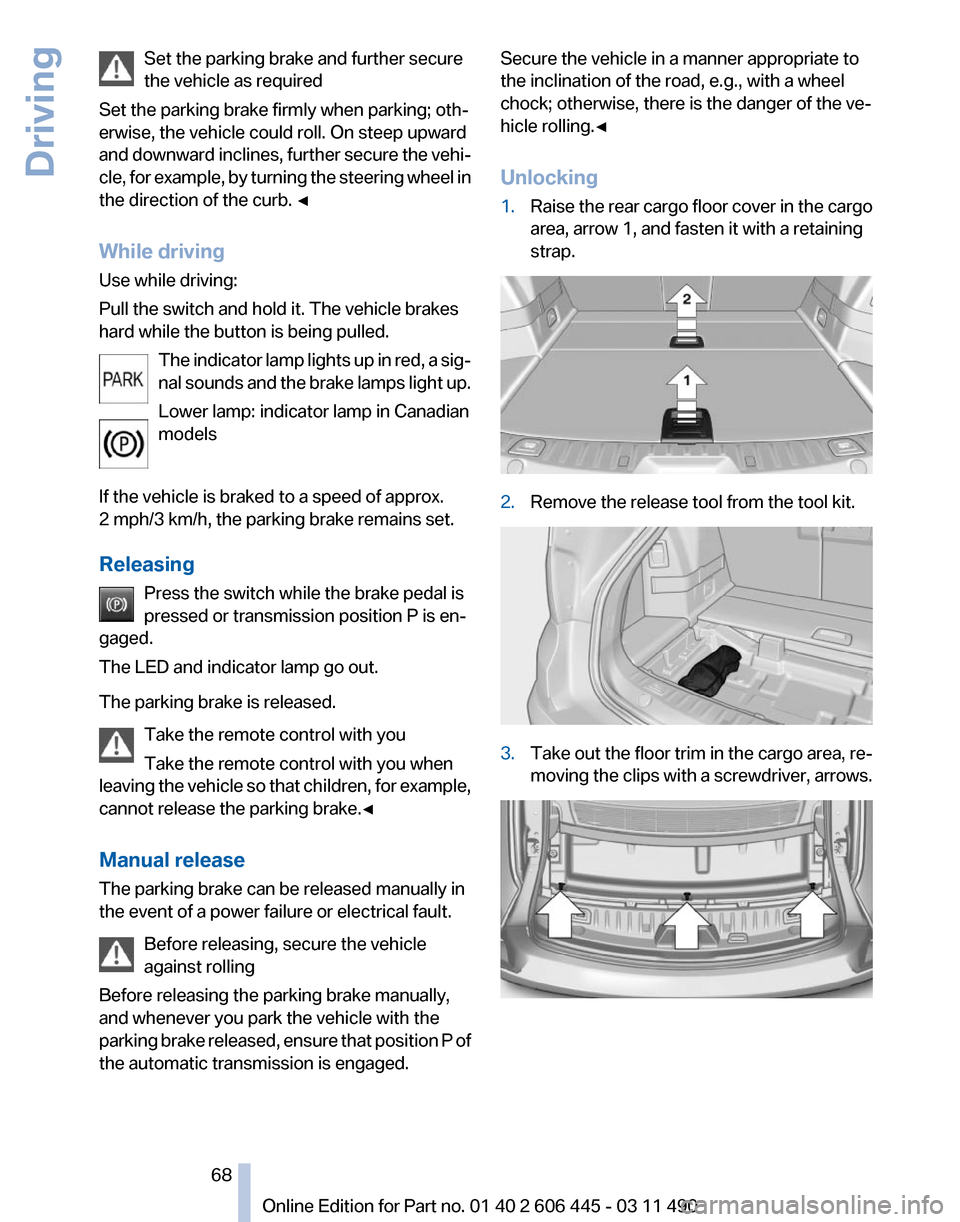
Set the parking brake and further secure
the vehicle as required
Set the parking brake firmly when parking; oth‚Äź
erwise, the vehicle could roll. On steep upward
and
downward inclines, further secure the vehi‚Äź
cle, for example, by turning the steering wheel in
the direction of the curb. ‚óÄ
While driving
Use while driving:
Pull the switch and hold it. The vehicle brakes
hard while the button is being pulled.
The indicator lamp lights up in red, a sig‚Äź
nal sounds and the brake lamps light up.
Lower lamp: indicator lamp in Canadian
models
If the vehicle is braked to a speed of approx.
2 mph/3 km/h, the parking brake remains set.
Releasing Press the switch while the brake pedal is
pressed or transmission position P is en‚Äź
gaged.
The LED and indicator lamp go out.
The parking brake is released.
Take the remote control with you
Take the remote control with you when
leaving the vehicle so that children, for example,
cannot release the parking brake.‚óÄ
Manual release
The parking brake can be released manually in
the event of a power failure or electrical fault.
Before releasing, secure the vehicle
against rolling
Before releasing the parking brake manually,
and whenever you park the vehicle with the
parking brake released, ensure that position P of
the automatic transmission is engaged. Secure the vehicle in a manner appropriate to
the inclination of the road, e.g., with a wheel
chock; otherwise, there is the danger of the ve‚Äź
hicle rolling.‚óÄ
Unlocking
1.
Raise the rear cargo floor cover in the cargo
area, arrow 1, and fasten it with a retaining
strap. 2.
Remove the release tool from the tool kit. 3.
Take out the floor trim in the cargo area, re‚Äź
moving
the clips with a screwdriver, arrows. Seite 68
68 Online Edition for Part no. 01 40 2 606 445 - 03 11 490
Driving
Page 70 of 297
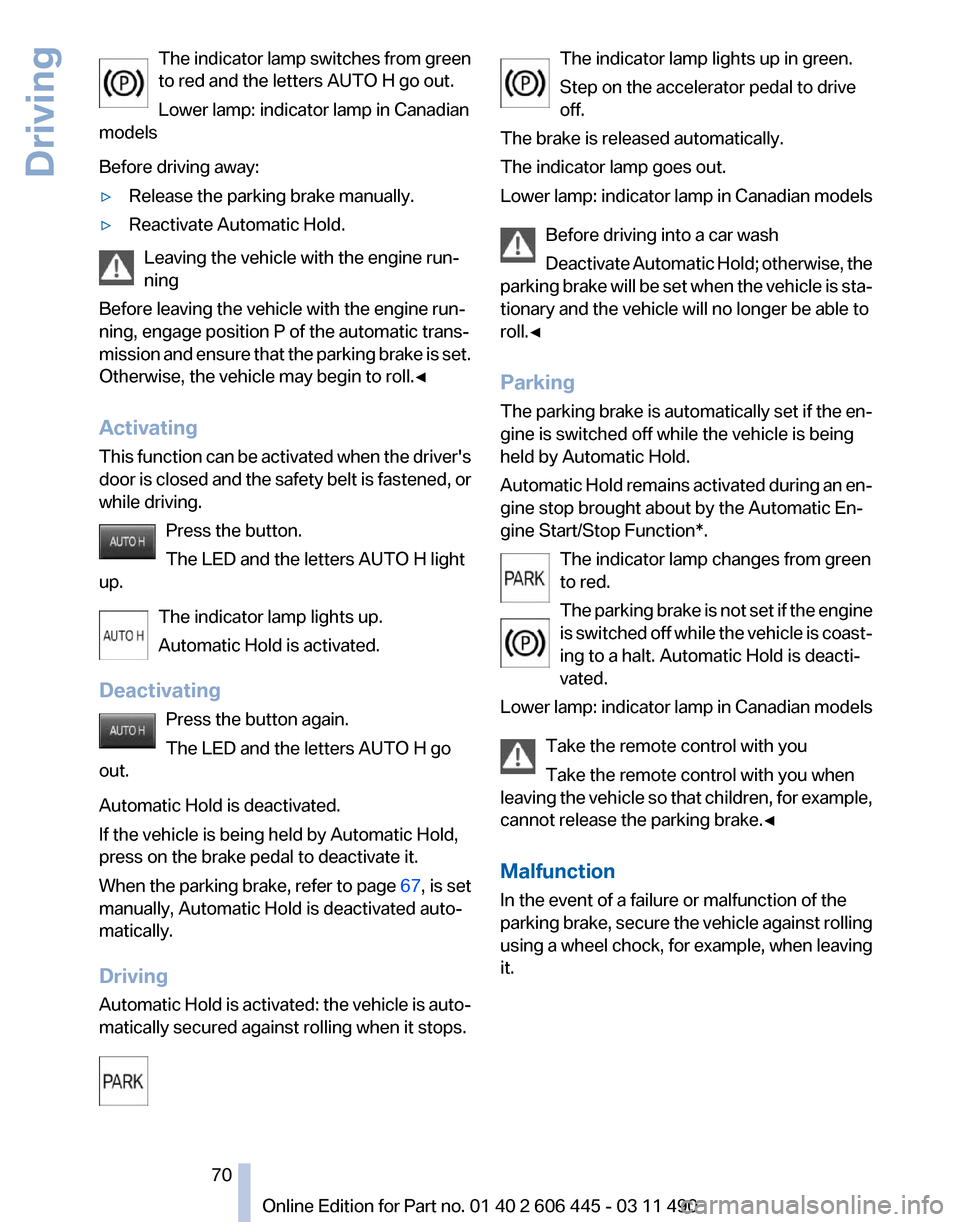
The indicator lamp switches from green
to red and the letters AUTO H go out.
Lower lamp: indicator lamp in Canadian
models
Before driving away:
‚Ė∑ Release the parking brake manually.
‚Ė∑ Reactivate Automatic Hold.
Leaving the vehicle with the engine run‚Äź
ning
Before leaving the vehicle with the engine run‚Äź
ning, engage position P of the automatic trans‚Äź
mission
and ensure that the parking brake is set.
Otherwise, the vehicle may begin to roll.‚óÄ
Activating
This function can be activated when the driver's
door is closed and the safety belt is fastened, or
while driving.
Press the button.
The LED and the letters AUTO H light
up.
The indicator lamp lights up.
Automatic Hold is activated.
Deactivating Press the button again.
The LED and the letters AUTO H go
out.
Automatic Hold is deactivated.
If the vehicle is being held by Automatic Hold,
press on the brake pedal to deactivate it.
When the parking brake, refer to page 67, is set
manually, Automatic Hold is deactivated auto‚Äź
matically.
Driving
Automatic Hold is activated: the vehicle is auto‚Äź
matically secured against rolling when it stops. The indicator lamp lights up in green.
Step on the accelerator pedal to drive
off.
The brake is released automatically.
The indicator lamp goes out.
Lower
lamp: indicator lamp in Canadian models
Before driving into a car wash
Deactivate Automatic Hold; otherwise, the
parking brake will be set when the vehicle is sta‚Äź
tionary and the vehicle will no longer be able to
roll.‚óÄ
Parking
The parking brake is automatically set if the en‚Äź
gine is switched off while the vehicle is being
held by Automatic Hold.
Automatic Hold remains activated during an en‚Äź
gine stop brought about by the Automatic En‚Äź
gine Start/Stop Function*.
The indicator lamp changes from green
to red.
The parking brake is not set if the engine
is switched off while the vehicle is coast‚Äź
ing to a halt. Automatic Hold is deacti‚Äź
vated.
Lower lamp: indicator lamp in Canadian models
Take the remote control with you
Take the remote control with you when
leaving the vehicle so that children, for example,
cannot release the parking brake.‚óÄ
Malfunction
In the event of a failure or malfunction of the
parking brake, secure the vehicle against rolling
using a wheel chock, for example, when leaving
it. Seite 70
70 Online Edition for Part no. 01 40 2 606 445 - 03 11 490
Driving
Page 71 of 297
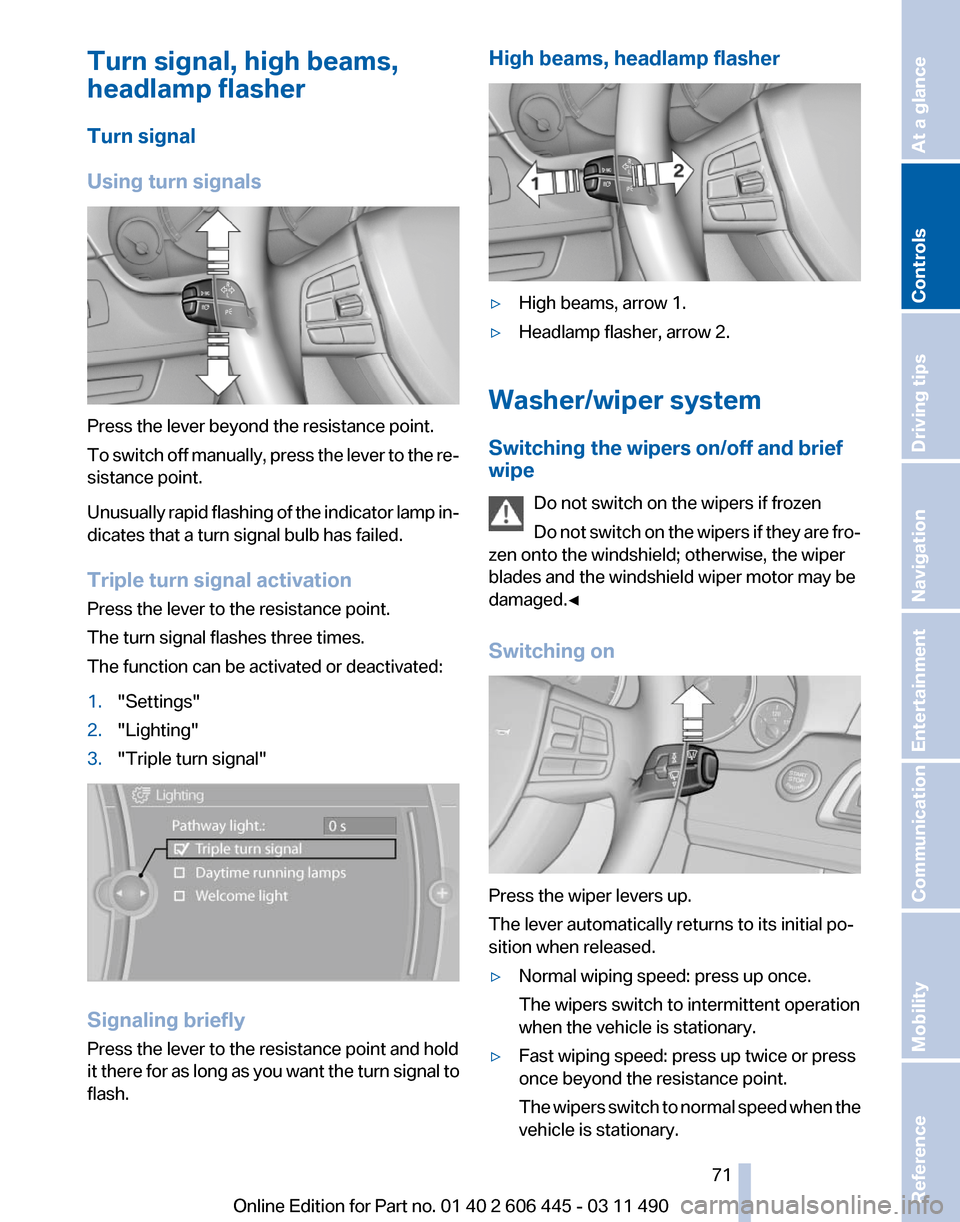
Turn signal, high beams,
headlamp flasher
Turn signal
Using turn signals
Press the lever beyond the resistance point.
To
switch off manually, press the lever to the re‚Äź
sistance point.
Unusually rapid flashing of the indicator lamp in‚Äź
dicates that a turn signal bulb has failed.
Triple turn signal activation
Press the lever to the resistance point.
The turn signal flashes three times.
The function can be activated or deactivated:
1. "Settings"
2. "Lighting"
3. "Triple turn signal" Signaling briefly
Press the lever to the resistance point and hold
it
there for as long as you want the turn signal to
flash. High beams, headlamp flasher
‚Ė∑
High beams, arrow 1.
‚Ė∑ Headlamp flasher, arrow 2.
Washer/wiper system
Switching the wipers on/off and brief
wipe Do not switch on the wipers if frozen
Do
not switch on the wipers if they are fro‚Äź
zen onto the windshield; otherwise, the wiper
blades and the windshield wiper motor may be
damaged.‚óÄ
Switching on Press the wiper levers up.
The lever automatically returns to its initial po‚Äź
sition when released.
‚Ė∑
Normal wiping speed: press up once.
The wipers switch to intermittent operation
when the vehicle is stationary.
‚Ė∑ Fast wiping speed: press up twice or press
once beyond the resistance point.
The
wipers switch to normal speed when the
vehicle is stationary. Seite 71
71Online Edition for Part no. 01 40 2 606 445 - 03 11 490
Reference Mobility Communication Entertainment Navigation Driving tips
Controls At a glance
Page 72 of 297
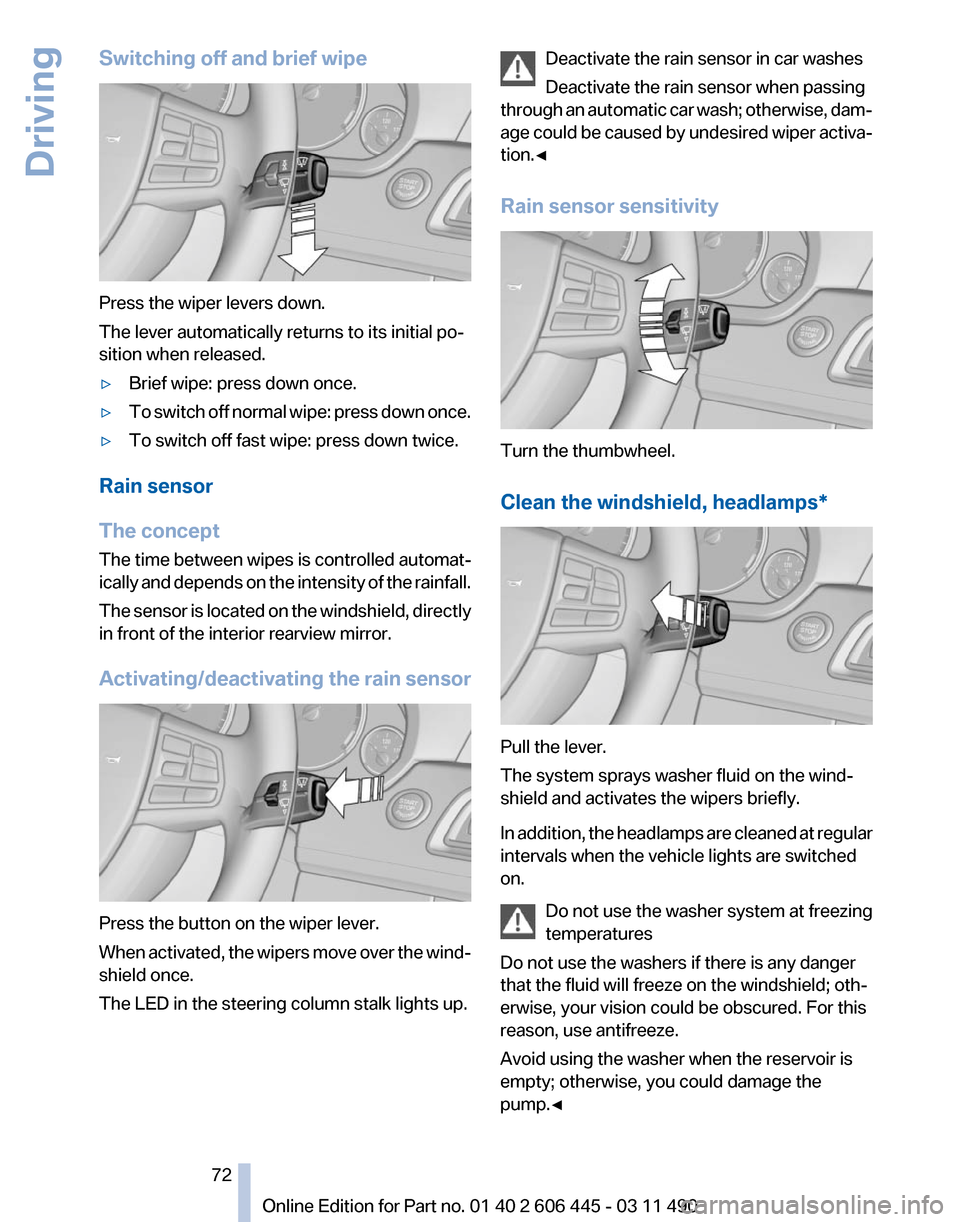
Switching off and brief wipe
Press the wiper levers down.
The lever automatically returns to its initial po‚Äź
sition when released.
‚Ė∑
Brief wipe: press down once.
‚Ė∑ To switch off normal wipe: press down once.
‚Ė∑ To switch off fast wipe: press down twice.
Rain sensor
The concept
The time between wipes is controlled automat‚Äź
ically
and depends on the intensity of the rainfall.
The sensor is located on the windshield, directly
in front of the interior rearview mirror.
Activating/deactivating the rain sensor Press the button on the wiper lever.
When
activated, the wipers move over the wind‚Äź
shield once.
The LED in the steering column stalk lights up. Deactivate the rain sensor in car washes
Deactivate the rain sensor when passing
through
an automatic car wash; otherwise, dam‚Äź
age could be caused by undesired wiper activa‚Äź
tion.‚óÄ
Rain sensor sensitivity Turn the thumbwheel.
Clean the windshield,
headlamps* Pull the lever.
The system sprays washer fluid on the wind‚Äź
shield and activates the wipers briefly.
In
addition, the headlamps are cleaned at regular
intervals when the vehicle lights are switched
on.
Do not use the washer system at freezing
temperatures
Do not use the washers if there is any danger
that the fluid will freeze on the windshield; oth‚Äź
erwise, your vision could be obscured. For this
reason, use antifreeze.
Avoid using the washer when the reservoir is
empty; otherwise, you could damage the
pump.‚óÄ Seite 72
72 Online Edition for Part no. 01 40 2 606 445 - 03 11 490
Driving